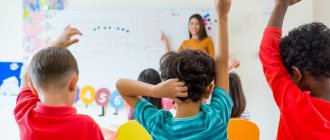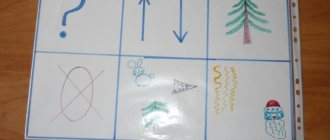Methodological developments for speech development using innovative methods
Taisiya Kashnikova
Methodological developments for speech development using innovative methods
Introduction
Speech development is one of the most important acquisitions of a child in preschool childhood and is considered in modern preschool education as a general educational problem. The development of speech is closely related to the development of consciousness , knowledge of the surrounding world, and the development of personality as a whole .
Traditional methods of teaching preschoolers recommend using a teacher's story sample as the main teaching technique. But experience shows that children reproduce the teacher’s story with minor changes, the stories are poor and inexpressive, and their vocabulary is small. Therefore, it became obvious that it is necessary to change the way teachers work in classes on the development of speech of preschoolers . Recently, the issue of using innovative technologies in preschool educational institutions , since the introduction of innovations into the work of an educational institution is the most important condition for improving and reforming the preschool education system
Language and speech have traditionally been viewed in philosophy, psychology and pedagogy as the “Center”
, in which various lines of psychological
development converge - thinking , imagination, memory, emotions. The development of speech in preschool childhood lays the foundation for successful learning at school.
Many educators are afraid of the phrase - innovative methods .
The purpose of this report: increasing professional competence in the field of speech development of preschool children through the use of innovative methods .
Tasks:
— Introduce teachers to effective methods and techniques for children’s speech development .
— Intensify the independent work of teachers, give them the opportunity to borrow elements of teaching experience to improve their own.
There are a large number of innovative methods . Let's consider some of them:
1. Didactic game for speech development “My, my, mine, mine”
for children of senior preschool age.
An educational game for speech development - teaching the correct use of the pronouns My, My, Mine, Mine in everyday speech , and the agreement of words by gender. Also, the game process contributes to the development of attention , memory, thinking, fine motor skills and will be exciting, interesting and educational for your child.
Goal: Formation of skills to coordinate pronouns with nouns.
Tasks:
• Help replenish and activate children's vocabulary.
• Improve the grammatical structure of speech .
• Develop attention , memory, thinking, fine motor skills, speech.
• Develop the ability to act alongside peers.
Age: The game is intended for children from 4 to 7 years old, no more than 4 people can play it.
2. Mnemotables
Mnemonics is a system of methods and techniques that ensure children’s successful acquisition of knowledge about the characteristics of natural objects, the world around them, effective memorization of the structure of a story, preservation and reproduction of information, and of course the development of speech .
The content of a mnemonic table is a graphic or partially graphic representation of fairy tale characters, natural phenomena, some actions, etc. by highlighting the main semantic links of the story’s plot. The main thing is to convey a conventionally visual diagram, to depict it in such a way that what is drawn is understandable to children.
Mnemonic tables-diagrams serve as didactic material in the work on the development of coherent speech in children . They are used for :
• enrichment of vocabulary,
• when learning to compose stories,
• when retelling fiction,
• when guessing and making riddles,
• when memorizing poetry.
These diagrams serve as a kind of visual plan for creating monologues and help children build:
- story structure,
- sequence of the story,
- lexical and grammatical content of the story.
Thus, using mnemonics techniques , we teach children:
- obtain information, conduct research, make comparisons, draw up a clear internal plan for mental actions and speech statements;
- formulate and express judgments, draw conclusions;
— the use of mnemonic techniques has a positive effect on the development of non-speech processes : attention, memory, thinking.
3. TRIZ
The purpose of TRIZ is to teach children to think systematically, with an understanding of the processes taking place, to give educators a tool for specific practical education in children of the qualities of a creative personality, capable of understanding the unity and contradiction of the world around them , and solving their own small problems.
One of the main indicators of the level of development of a child’s mental abilities can be considered the richness of his speech .
The use of adapted TRIZ methods in the process of speech development of preschool children contributes to:
• activation of children's cognitive activity;
• creating motivational guidelines for creativity;
• creating conditions for the development of the figurative side of children’s speech (enrichment of the vocabulary of evaluative vocabulary, words with figurative meaning, synonyms and antonyms);
• increasing the efficiency of mastering all language means.
4. Didactic game “Prepositions”
.
Goal: To teach to understand the meaning of prepositions: on, in, for, under, to, from, by, about, etc.; differentiate prepositions: on - in, on - under; use them correctly in speech ; make sentences with prepositions for demonstrating actions, using plot and subject pictures, according to the preposition scheme.
The material will help you understand the meaning of prepositions: on, in, for, under, to, from, by, about, etc. It will teach you to differentiate prepositions: on - in, on - under; use them correctly in speech . And also make sentences with prepositions for demonstrating actions, using plot and subject pictures, according to the preposition scheme.
5. Lapbook
Lapbooks allow a child to think, fantasize and act without fear of making mistakes. By training our fingers, we have a powerful impact on the performance of the cerebral cortex, and, consequently, on the development of speech . This makes it possible to develop both speech and related non-speech activities in children with special needs.
Lapbooks allow a child to think, fantasize and act without fear of making mistakes. By training our fingers, we have a powerful impact on the performance of the cerebral cortex, and, consequently, on the development of speech . This makes it possible to develop both speech and related non-speech activities in children with special needs.
Using a lapbook as an unconventional technique for correcting sound pronunciation and a dictionary allows you to: clarify the existing dictionary; activate and enrich the vocabulary through teaching various ways of word formation. All this creates the basis for correcting sound pronunciation not only “artificially”
way, but also
“naturally”
, through
the development of the lexical and grammatical side of speech .
6. Breathing exercises.
Correct speech breathing ensures clear diction, pronunciation of sounds, due to normal sound production, sufficient volume, observance of pauses, maintaining the smoothness of speech and its expressiveness. Breathing exercises allow you to develop a strong, smooth, elongated exhalation and form a targeted air stream - this allows the child to more quickly master difficult-to-pronounce sounds.
It should be recalled that when establishing proper breathing, there are general rules for performing exercises:
- exercise in a well-ventilated room, at a temperature of 18-20 degrees.
-clothing should not hinder movement.
-do not exercise immediately after eating.
- if you have an acute respiratory disease, it is prohibited to exercise.
- the accompanying text is spoken by an adult.
It is necessary to monitor the technique of performing exercises:
-take air through the nose.
-do not raise your shoulders.
-exhalation should be long and smooth.
- do not puff out your cheeks.
- dose the exercises (individually, as you may feel dizzy.
The presentation can be viewed at the link: https://yadi.sk/i/xPgavKAXgfoQ3g
Junior group. Early childhood, nursery. Children 1-4 years old
Consultation for teachers “Organization and methods of conducting experimental games in early preschool age groups” Children of early preschool age are characterized by visual-figurative thinking. For kids of this age, experimentation, along with play, is a leading activity. While playing in early age groups, children begin to take part in joint experiments...
Self-education folder “Didactic game as a form of teaching young children” Self-education dad Topic: “Didactic game as a form of teaching young children”
PERSONAL PERSPECTIVE PLAN FOR SELF-EDUCATION Topic:
“Didactic game as a form of teaching young children”
Goal: to increase professional competence on the topic. Tasks: •…
Senior group. Senior preschool age. Children 5-6 years old
Work plan for self-education “Development of creative abilities in children 4–5 years old through non-traditional drawing techniques” Period of work on the topic: 1 year Month of starting work on the topic: September 2021 Month of completion of work: May 2022 Goal: Increasing your theoretical level professional skills and competence on the development of artistic skills in preschool children...
Self-education program “Outdoor games in the system of forming targets for the Federal State Educational Standard before” (senior group) DEPARTMENT OF EDUCATION OF THE ADMINISTRATION OF THE CHKALOVSKY DISTRICT Self-education program on the topic: “Outdoor games in the system for forming targets for the Federal State Educational Standard before”
by teacher of the senior group Nina Vitalievna Myasnikova Relevance Outdoor game - conscious, motor activity...




